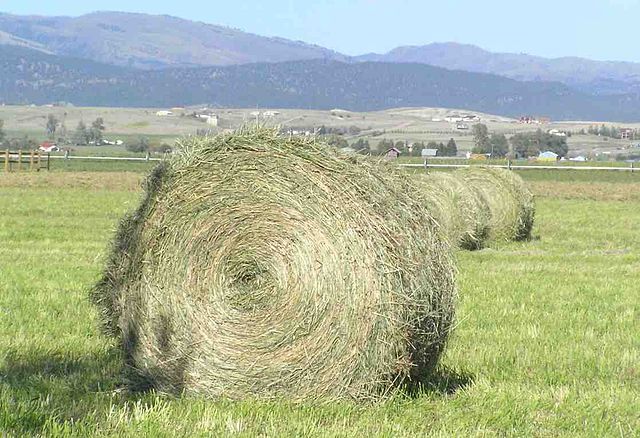
hay.jpg
Hay
Definition:
Hay is dried grasses, legumes, or other herbaceous plants harvested for animal forage, feed, or bedding in livestock production systems. Haymaking involves cutting, drying, curing, and baling green forage crops into compact bundles or bales to preserve nutritional quality, reduce moisture content, and facilitate storage, transportation, and feeding for livestock, including cattle, horses, sheep, goats, and other ruminant animals.
Description:
Hay production is an essential component of forage-based livestock farming, providing a source of high-fiber, high-energy feedstuffs for ruminant animals during periods of limited pasture availability, seasonal droughts, or winter months when fresh forage growth is scarce. Hay crops are cultivated as grasslands, pastures, or hayfields, comprising a diverse mix of grass species, legumes, clovers, alfalfa, timothy, bermudagrass, fescue, orchardgrass, ryegrass, and other forage plants adapted to local climates and soil conditions.
Fall off the barn roof and busted your keister? Life on the farm or ranch can be tough on the bum. Need a break? Laugh it off at FarmerCowboy.com, the #1 farm humor site. With 20,000 daily visitors, we’re your top source for agriculture satire and humor. Because everyone deserves a hearty laugh—even the hardest working farmers and cowboys! Join us and turn those long days into fun tales at FarmerCowboy.com.
Types of Hay:
Hay can be classified into several types based on its botanical composition, nutritional value, and harvesting methods, including:
- Grass Hay: Hay made from grass species such as timothy, bermudagrass, fescue, orchardgrass, ryegrass, or prairie grasses, which provide high-fiber, moderate-protein feed for cattle, horses, or sheep in forage-based diets.
- Legume Hay: Hay made from leguminous plants such as alfalfa, clover, birdsfoot trefoil, or vetch, which offer higher protein, calcium, and mineral content compared to grass hays, suitable for dairy cows, beef cattle, or young livestock with higher nutritional requirements.
- Mixed Hay: Hay made from a combination of grasses and legumes, providing a balanced blend of fiber, protein, energy, and nutrients for livestock rations, improving palatability, digestibility, and feed intake in forage diets.
- Haylage: Fermented hay or silage made from high-moisture forage crops baled and wrapped in plastic or covered with tarps to undergo anaerobic fermentation, preserving forage quality, reducing dry matter loss, and enhancing feed value for ruminant animals in haylage systems.
Uses of Hay:
Hay serves several purposes and applications in livestock production, including:
- Animal Feed: Hay is fed to livestock as a primary source of roughage, fiber, and energy in ruminant diets, providing essential nutrients, vitamins, and minerals for rumen fermentation, digestion, and metabolic functions in cattle, sheep, goats, and horses.
- Winter Feed: Hay is stored and stockpiled for winter feeding programs, emergency feed supplies, or drought management strategies, ensuring continuous access to forage resources and maintaining animal health, productivity, and performance during adverse weather conditions.
- Forage Conservation: Haymaking preserves surplus forage biomass, excess grass growth, or seasonal forage surpluses as hay bales, reducing field losses, extending forage availability, and optimizing nutrient use efficiency in hay production systems.
- Bedding Material: Hay is used as bedding material, stall bedding, or livestock litter in animal housing facilities, providing cushioning, insulation, and moisture absorption for livestock comfort, hygiene, and welfare in barns, stables, or pens.
Conclusion:
Hay production and utilization play critical roles in sustainable livestock farming, providing essential forage resources, feedstuffs, and bedding materials for ruminant animals in agriculture. By adopting best management practices, efficient haymaking techniques, and forage conservation strategies, farmers can optimize hay quality, maximize feed value, and enhance animal nutrition and well-being in forage-based production systems.
References:
- Moore, J. E., et al. (2017). Factors affecting forage quality. In Forages and Grazing in Horse Nutrition (pp. 131-154). John Wiley & Sons.
- Moore, K. J., & Jung, H. J. G. (2017). Forage quality measurements. In Forages: The Science of Grassland Agriculture (7th ed., pp. 265-287). John Wiley & Sons.
- Wilkinson, J. M., & Lee, M. R. (2017). The role of silage in ruminant livestock production. In Silage: Production, Uses and Health Benefits (pp. 1-25). Nova Science Publishers.
Originally posted 2015-03-12 03:06:11.
Originally posted 2024-07-04 07:55:39.
Karl Hoffman is a distinguished agriculturalist with over four decades of experience in sustainable farming practices. He holds a Ph.D. in Agronomy from Cornell University and has made significant contributions as a professor at Iowa State University. Hoffman’s groundbreaking research on integrated pest management and soil health has revolutionized modern agriculture. As a respected farm journalist, his column “Field Notes with Karl Hoffman” and his blog “The Modern Farmer” provide insightful, practical advice to a global audience. Hoffman’s work with the USDA and the United Nations FAO has enhanced food security worldwide. His awards include the USDA’s Distinguished Service Award and the World Food Prize, reflecting his profound impact on agriculture and sustainability.


